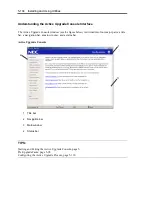
5-100 Installing and Using Utilities
TIPS:
Pre-Upgrade Tasks on page 5-96
Configuring the Active Upgrade Process on page 5-110
Gathering Information
Before you start configuring the Active Upgrade process on your system, considering the following
questions:
Did you decide the IP address for the Active Upgrade?
This IP address should be the same network address that is allocated to Ethernet team and
should be a new one.
After you complete this upgrade, will you ever want to run the same type of upgrade again? If
so, plan to create a configuration file with the details of your upgrade, so you can use it again at
a later date.
Did your support provider give you a configuration file that you could use as a template for
your specific system and the type of upgrade you are performing? Or, do you have settings
from other existing configuration files that you want to incorporate into your current
configuration? (If applicable, you might be able to use more than one configuration file at a
time by nesting them).
Which disks in your system contain the software you want to upgrade? Which disks cannot or
should not be upgraded given the prerequisites of the Active Upgrade process? You will need
to select these disks before splitting the system.
Which software installation utilities are you going to run during the Active Upgrade process?
(If you are copying these to the system from a network resource, you need to do so before
initiating split mode.) Do any of these installer programs require access to the network or data
disks during the upgrade? (If so, you cannot use them with Active Upgrade technology.)
How do you start and stop critical applications on the system you want to upgrade? Are the
applications configured as services in the Services snap-in to Microsoft Management Console?
Or do you need to run custom actions (executables such as .bat, .vbs, .exe) to start your
applications, possibly in a particular order? You need to identify these services and custom
actions during configuration to allow the Active Upgrade Console to start and stop your
applications at the appropriate times during the upgrade process. See “Managing Critical
Applications During the Upgrade Process” on page 5-95 for more information.
Do you want to preserve Event Viewer log entries that are generated on the Production Side
while the system is running in split mode? These log entries are typically lost during the
commit process, when the system resynchronizes your RDR disks. If you want to save the files,
you can configure the Active Upgrade Console to copy them to a backup directory before it
commits the upgrade. You can save the standard log files as well as any custom log files you
have opened in the Event Viewer.
When you finish answering these questions, you can use the worksheet on the next page to record
your configuration information.
Summary of Contents for Express5800/320Fd-MR
Page 13: ...v Appendix B I O Port Addresses This appendix lists factory assigned I O port addresses...
Page 19: ...xi THIS PAGE IS INTENTIONALLY LEFT BLANK...
Page 43: ...2 10 General Description Rear View...
Page 47: ...2 14 General Description CPU IO Module CPU IO module...
Page 67: ...2 34 General Description This page is intentionally left blank...
Page 79: ...3 12 Windows Setup and Operation 3 Confirm that RDR of the disk is cancelled...
Page 106: ...Windows Setup and Operation 3 39 This page is intentionally left blank...
Page 198: ...4 92 System Configuration This page is intentionally left blank...
Page 370: ......
Page 371: ...This page is intentionally left blank...
Page 389: ...6 18 Maintenance 3 Stop of PCI module 1 4 Start of PCI module 1...
Page 391: ...6 20 Maintenance This page is intentionally left blank...
Page 465: ...System Upgrade 8 31 board must not be mixed with N8804 005 or N8803 035...
Page 480: ......
Page 483: ......
















































